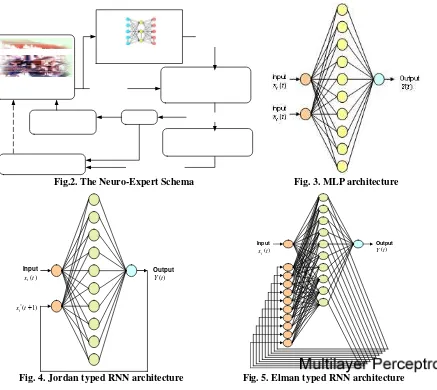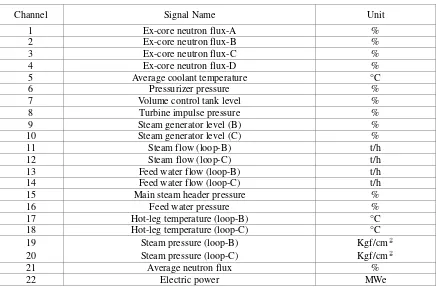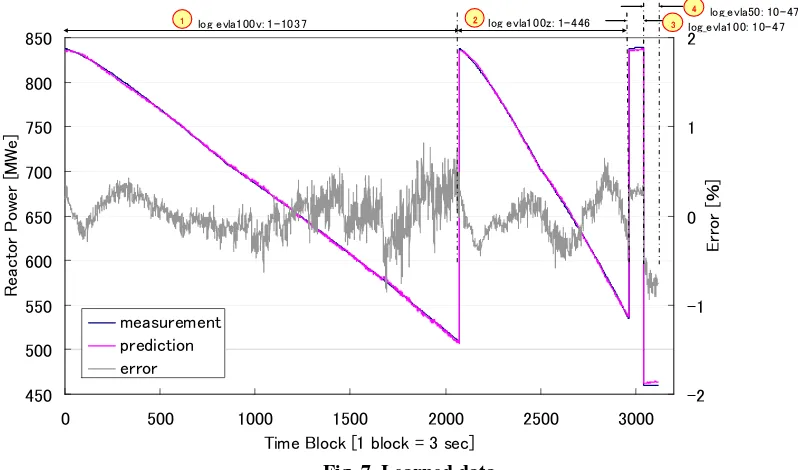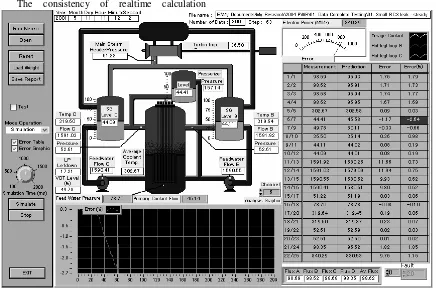THE IMPROVEMENT OF NEURO-EXPERT METHOD FOR ANOMALY
DETECTION IN NUCLEAR REACTOR
Muhammad Subekti
Centre for reactor technology and nuclear safety (PTRKN) - BATAN, Puspiptek Complex OBN.80 Serpong Tangerang, Indonesia
Email: [email protected]
ABSTRACT
The improvement of Neuro-Expert Method have been done for anomaly detection in nuclear reactor by utilization of Recurrent Neural Network (RNN). The development of Multilayer Perceptron (MLP) for similar objective was done in the previous research. Due to the monitoring system needs of redundancy to assure the reactor safety, the Neuro-Expert have been improved in this research by utilization of RNN as added method. Furthermore, the expert system is coupled to MLP and RNN by using specific parameters which depend on the training characteristic. The offline demonstation of MLP and RNN were carry out for PWR Borselle, simulator of PWR Surry-1, RSG-GAS reactor, and High Temperature Engineering Tested Reactor (HTTR). The learning results showed unsignificant different of maximum error of 0.0061 for MLP and 0.0049 for Jordan typed RNN. In the contrary, Elman typed RNN gave unreliable maximum error of 0.0130.
Keywords: improvement, Neuro-Expert, multilayer perceptron, Recurrent Neural Network, anomaly detection.
ABSTRAK
Perbaikan metode Neuro-Expert untuk mendeteksi anomali di reaktor nuklir dengan memanfaatkan
Recurrent Neural Network (RNN) telah dilakukan. Pada penelitian sebelumnya, pengembangan metode
Multilayer Perceptron (MLP) untuk tujuan yang sama telah dilakukan. Karena sistem monitoring memerlukan redundansi untuk menjamin keselamatan reaktor, maka pada penelitian sekarang ini, metode
Neuro-Expert diperbaiki dengan memanfaatkan RNN sebagai metode tambahan. Dan selanjutnya, sistem pakar pada MLP dan RNN menggunakan parameter optimasi yang spesifik sesuai dengan karakteristik pelatihan. Demonstrasi MLP dan RNN secara offline telah dilakukan dengan menggunakan data PWR Borselle, simulator PWR Surry-1, Reaktor RSG-GAS, dan High Temperature Engineering Tested Reactor
(HTTR). Hasil pelatihan menunjukkan perbedaan yang tidak signifikan dimana maximum error sebesar 0,0061 untuk MLP dan 0,0049 untuk RNN tipe Jordan. Sebaliknya, RNN tipe Elman memberikan maximum error sebesar 0,0130.
Katakunci: improvement, Neuro-Expert, multilayer perceptron, Recurrent Neural Network, anomaly detection.
1. INTRODUCTION
The planning of first nuclear power plant development (NPP) in Indonesia has been on the news and almost all of the Indonesia peoples have heard about it. Simultenously, the experience of world NPP operation that more than 12 thousand years in 5 decades proves that NPP accident risk is acceptable by most publict. However, the Pressurized Water Reactor (PWR) that will be developed in Indonesia is completely different with Chernobyl reactor, especially in the point of view of the Chernobyl`s safety concepts are inadequate
comparing to PWR. The western NPP has proven passive and active safety features. Besidedefense in depth (DID), for example NPP have a passive limitation of power increase through a negative reactivity increase when fuel temperature increase rapidly. Three Mile Island accident showed that the DID offer protection against the unforeseen and the unknown possible events. Chernobyl, on the contrary, is a completely opposite principle that the safety margins were not stringent enough. Moreover, new PWR is capable to detect any anomalies before accident.
intelligence such as neural network, expert system, genetic algorithm etc. The combination of neural network and expert system has been tested offline at NPP Borselle, Nederland (1). Monitoring system used neural network has been developed in Indonesia as well and tested offline (2) and demonstrated online at multipurpose reactor GA Siwabessy (MPR-GAS) (3). The research and development of monitoring system using artificial
intelligence in USA gives also many efforts (4). The neural network application for big scale monitoring system in Japan has been done by involving distributed architecture concepts to assure the realtime calculation process(5). Lastly, the monitoring system using Neuro-Expert, noise analysis, and modified neural network has been demonstrated realtime at High Temperature Engineering Tested Reactor (HTTR) (6).
redundant
Data Acquisition
Isolated Amplifier
Viewer
Fig.1. Monitoring system utilized MLP and RNN
The present research objective is to improve the monitoring system for nuclear reactor by utilization of anomaly detection method using Recurrent Neural Network (RNN). Consequently, the safety will be also improved by reliable redundancy in monitoring system. The previous research has utilized Multilayer Perceptron (MLP) for anomaly detection method. The present research utilized RNN as redundant method as shown in
Fig.1.
Generally, MLP architecture is simpler than RNN made the response time of anomaly detection is faster (7). Due to the redundancy reason, the development of other method should be done. However, the research focused on the improvement by RNN development consist of Jordan typed RNN and Elman typed RNN. The learned results showed unsignificant different of maximum error of 0.0061
for MLP and 0.0049 for Jordan typed RNN. In the contrary, Elman typed RNN gave unreliable maximum error of 0.0130.
2. METODOLOGY
Anomaly Detection Using RNN
The anomaly detection principle is error monitoring resulted by the difference of calculated value and measured value. Before the monitoring, the MLP has carried out learning. The measurement data as teaching data was learned for the plant condition of start-up, power rise, and stable. The calculated value minus teaching value, dj - Yk gives
error, ek that represents the optimum pattern to be performed by the MLP as known supervised learning paradigm. Hence, the signal error
concludes a square error, E, by the equation [1] :
k k
k
d
Y
e
=
−
, and∑
=
=
K k ke
E
1 22
1
(1)Thus, learning carries out the update of synaptic weights iteratively with the aim of eventually making the MLP emulate the measured outputs. The weight updates (Δwjk
t
) at iteration time t′are calculated by the delta rule equation below:
' ' ' t jk t t jk
W
E
w
∂
∂
−
=
Δ
η
, and ' ' '( )
' '' t k t k k t k t t
y
e
W
E
=
−
ϕ
υ
∂
∂
(2)
where j is input index, k is output index, and η is a constant that determines as the learning rate. The
weight updates assisted by error function iterate the network iterated until it reaches a suitable error. Therefore, the update of the weights makes the environment knowledge available to the calculated value during learning that is reachable through network iteration number. MLP has teacher in input-output learning due to the complexity of the model. After an appropriate weight is reached, the forward calculation does not perform weight update and merely straight fast calculation. Therefore, the hypothesis of MLP application is that successful modeling must be achieved.
Fig.2. The Neuro-Expert Schema Fig. 3. MLP architecture
Input ) (t xi ) 1 ( * + t xi Output ) (t Y Input ) (t xi Output ) (t Y
Fig. 4. Jordan typed RNN architecture Fig. 5. Elman typed RNN architecture
The different of MLP and RNN is that MLP does not has recurrent signal or feedback signal from output layer to input layer. Figure 2 shows the Neuro-Expert schema, in which the neural network is coupled with expert system. The data receives from DAQ module at server PC and be directly computed by MLP. Only in anomaly condition, the error of calculated value is significant increase until
we refer again to the point kinetic model. Jordan typed RNN inserted feedback signals from output signal with value constant γ called feedback rate as in the formula below:
)
1
(
1
=
γ
+
−
γ
+ t t
i t
i
x
Y
x
,0
≤
γ
≤
1
(3)where γ is recurrent parameter, is the input
of feedback signal at time , is the input
of feedback signal at time
t
, andY
is the network output.1 +
t i
x
1
t
+
x
it0 60 120 180 240 300
38 40 42 44 46
0 200 400 600 800 1000
-6 -4 -2 0 2 4 6 8 10
Error [%]
Channel 6: Pressurizer P
ressure [%]
Time [sec]
Small RCS leak 50 gallon/min
Measurement
Neural Net
Anomaly detected by Neural Net
Error
Fault level setting
Anomaly Start
Fig.6. Anomaly detection using neural network (6)
Table 2. The monitored channel name for PWR
Channel Signal Name Unit
1 Ex-core neutron flux-A %
2 Ex-core neutron flux-B %
3 Ex-core neutron flux-C %
4 Ex-core neutron flux-D %
5 Average coolant temperature °C
6 Pressurizer pressure %
7 Volume control tank level %
8 Turbine impulse pressure %
9 Steam generator level (B) %
10 Steam generator level (C) %
11 Steam flow (loop-B) t/h
12 Steam flow (loop-C) t/h
13 Feed water flow (loop-B) t/h
14 Feed water flow (loop-C) t/h
15 Main steam header pressure %
16 Feed water pressure %
17 Hot-leg temperature (loop-B) °C
18 Hot-leg temperature (loop-C) °C
19 Steam pressure (loop-B) Kgf/cm2
20 Steam pressure (loop-C) Kgf/cm2
21 Average neutron flux %
22 Electric power MWe
The monitored channel name for PWR could be checked in Table 2. In the initial learning, every dataset pattern consists of 22 input signals to perform 22 monitoring channel objects. The input signals are also normalized in [-1, 1] before entered to neural network to make all the input elements lie normally between 1 and -1. However, the MLP itself can merely detect an error from the normal state by monitoring the error, the difference between the measured signal and the calculated signal; the condition of the error or difference needs an expert system interpretation to diagnose the causes.
The MLP and RNN are monitoring the difference of calculated result and measured value. So that the method could give alert when the error exceeding the fault level. The small error in a signal
channel indicates the operation is normal. An example of anomaly condition that could not reach in PWR Borselle and capable to be simulated using PWR simulator Surry-1 is anomaly of small reactor coolant system leakage (RCS leak) 50 gallon/minute at 100% power reactor. This anomaly is indicated by the fault of channel number 6, pressurizer pressure [%]. The setting fault level is 1.5%. The error exceeded the fault level in 34 seconds after anomaly was started. It means the neural network detected successfully the anomaly faster that conventional method that detect the same problem in 5 minutes 30 second (7). Figure 6 shows anomaly detection using neural network in case of small reactor coolant system leakage (RCS leak) 50 gallon/minute at 100% power reactor.
450 500 550 600 650 700 750 800 850
0 500 1000 1500 2000 2500 3000
Time Block [1 block = 3 sec]
R e a c to r P o w e r [M W e ] -2 -1 0 1 2 E rr o r [% ] measurement prediction error
1 2 3
4
log evla100v: 1-1037 log evla100z: 1-446 log_evla100: 10-47log_evla50: 10-47
Fig. 7. Learned data
Furthermore, the expert system task is analyzing the output of neural network to find the anomaly cause. A certain anomaly always gives specific alert in sequence of channel fault. Hence, the expert system should study the knowledge about the sequence of channel fault and interpret it as expert rule. However, the anomaly in HTTR could not identify completely so that the application of neuro-expert using MLP utilized simpler expert rule temporarily than developed expert rule for PWR in previous research. Therefore, development of neuro-expert for HTTR would provide an updateable expert rule sufficient to not degrade the computer based system’s reliability and able to be upgraded.
Monitoring System Requirements
The utilization of some applications in a monitoring system could impair the stability of
realtime calculation process. The consistency of realtime process requires global system assessment started from data acquisition (DAQ) until graphic user interface (GUI). Table 2 shows the parameter name of PWR signal channel and the validation range. The acquired data number is 22 channels in which the new DAQ was developed parallel to the standard DAQ. In data acquisition process, the signal conditioning circuitry for general measurement is fairly straightforward. It consists of the signals itself (come from each sensor), an instrumentation isolated amplifier to boost the sensor’s signal level and isolate its signals, a low pass filter to reduce noise and prevent aliasing in the data acquisition system, and finally, simultaneous sample and hold circuitry to keep the signals properly timed with respect to each other.
PWR Surry-1, RSG-GAS reactor, and HTTR.
Figure 7 shows the learned data for PWR with random order input for every iteration cycle. In this case, the learned data consist of 1037 patterns of 1.5%/min power decreasing, 446 patterns of 3.5%/min power decreasing, 37 patterns of 100% steady state power and 37 patterns of 50% steady state power operation. MLP and RNN learned the similar data and the learning result will be comparable.
The consistency of realtime calculation
process requires optimal design so the each application could not impair the other realtime process by other applications. The calculation load should be shared to the other computer for optimal process by adopting distributing architecture.
Figure 1 described monitoring system contains of many applications including MLP application and an application could place at a computer and other application places at other computer.
Fig.8. GUI Panel of RNN application for PWR
0 20 40 60 80 100 120 140 160 180
44.0 44.5 45.0 45.5 46.0
-0.1 0.0 0.1 0.2 0.3
0 20 40 60 80 100 120 140 160 180
Fault S etting Erro
r [
%
]
Primary P
ressure Wa
te
r Coolan
t F
low [
t/
h
]
T im e [sec]
M easurem ent P rediction
E rror
Fig. 9. The example of monitoring result to parameter of PPWC flow
Table 3. The learning result
Method Max Error [-]
MLP 0.0061
Elman typed RNN 0.0130
Jordan typed RNN 0.0049
The DAQ, MLP-expert, RNN-expert, TSS-MLP, TD Jordan RNN, and other application that possible developed in the future; calculate at personal computer (PC) for each application. The distributed architecture involves client-server with TCP-IP connection. The communication bridge starts from client PC placed by DAQ, then the data spread to each client PC.
3. OFFLINE DEMONSTRATION
The developed MLP application was tested offline by using experiment data. Figure 8 shows GUI Panel of RNN application for PWR. From this panel, the optimal weight file and fault setting should be entered. The panel contains four functions that could be accessed by change the tab windows. Figure 9 shows the example of monitoring result to parameter of PPWC flow [t/h] in offline testing. The offline data was taken from experiment at 11 Dec 2006, start-up on 17:14:39 until 17:16:04. The anomaly could be detected by RNN as shown by Fig. 3 at PWR case.
Table 3 shows the learning result of MLP and RNN. The improvement does not involved the Elman typed RNN due to the error of learning result is significantly higher than MLP and RNN.
Table 3 shows that learning result of Jordan typed RNN is better that MLP as well. Accoding to the kinetic modeling of nuclear reactor, the outputs have feedback to next calculation. This phenomena agree with the modeling done by Jordan typed RNN. However the feedback from hidden layer in Elman typed RNN does not give better result than MLP due to the uncompability of the modeling. So the modeling is the key for neural network development or improvement. And the convergency does not depend on epoch, but depend on the achievement of the gradient of learning stability. Some times the epoch give untrue network weights and usefull for simpler problem.
4. CONCLUSION
The improvement of monitoring system by developing another alternative method for anomaly
detection using RNN was done. MLP and RNN work parallel to create redundant method in monitoring system. MLP and RNN learning were carried out by using similar data. The modeling is the key for neural network development or improvement. The learning results showed unsignificant different of maximum error of 0.0061 for MLP and 0.0049 for Jordan typed RNN. In the contrary, Elman typed RNN gave maximum error of 0.0130 which is significant different comparing to MLP and Jordan typed RNN.
5. REFERENCES
1. Nabeshima K., Suzudo T., Seker S., Ayaz E., Barutcu B., Turkcan E., Ohno T., Kudo K, 2003, “On-line Neuro-expert Monitoring System for Borselle Nuclear Power Plant”,
Progress in Nuclear Energy, Vol. 43, No. 1-4, pp.397-404.
2. Pinem S. Surbakti T., Nabeshima K., 2003, “Reactor Monitoring with Neuro-Expert for RSG-GAS”, Physics Journal of the Indonesia Physical Society, Vol. A5, No.0216.
3. Nabeshima K., Kristedjo K., Surbakti T., Pinem S., Subekti M., Minakuchi Y., Kudo K., 2005, “On-line Reactor Monitoring with Neural Network for RSG-GAS”, Proceeding of Computational Intelligence Methods and Applications (ICSC), Istanbul, December, Turkey.
4. Hines J.W. and Davis E., 2005, “Lessons Learned From the US Nuclear Power Plant On-line Monitoring Programs”, Progress in Nuclear Energy, Vol.46, No.3-4, pp.167-175. 5. Subekti M., Ohno T., Kudo K., Nabeshima K.,
Takamatsu K., 2005, “Full Integrated System of Real-Time Monitoring Based on Distributed Architecture for the High Temperature Engineering Test Reactor (HTTR)”, Proceeding of Global 2005, Tsukuba, Japan, October 9-13.
of The 5th International Topical Meeting on Nuclear Plant Instrumentation Control and Human Machine Interface Technology (NPIC&HMIT 2006), Albuquerque NM, November 12-17, United State.
7. Subekti M., Ohno T., Kudo K., Nabeshima K., 2006, “Development of PWR Monitoring System Using Neuro-Expert”, Proceeding of The 2nd Information and Communication Technology Seminar (ICTS) 2006, Surabaya, Indonesia.
8. Ueta S., Sumita J., Emori K., Takahashi M., Sawa K., 2003, “Fuel and Fission Gas Behavior during Rise-to-Power Test of the High Temperature Engineering Test Reactor (HTTR)”, Journal of Nuclear Science and Technology, vol.40, No.9, p679.
9. Saito, 1994, “Design of High Temperature Engineering Test Reactor (HTTR)”, Report of The Japan Atomic Energy Research Institute, JAERI-1332.




